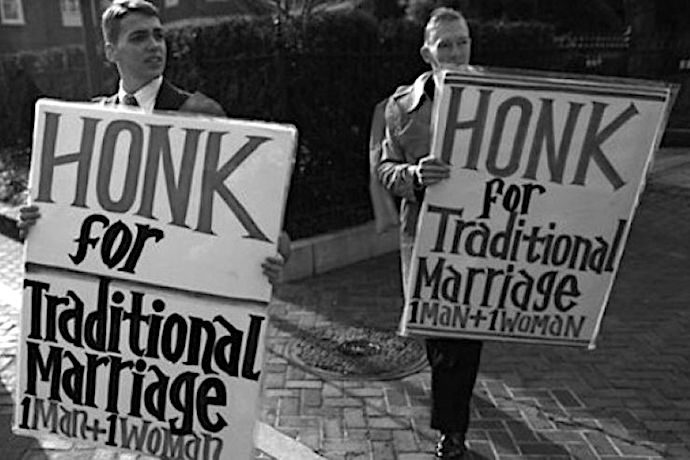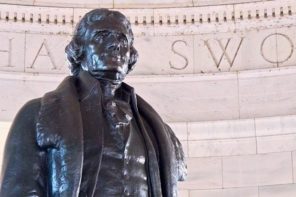For the past week or so, the National Review‘s Alexandra Desanctis and I have been debating some of the finer points of both “religious freedom” and religious freedom. On Monday she published a response to my piece critiquing her analysis of Nico Lang’s Salon report highlighting the unpopularity of anti-LGBT “religious freedom” efforts. In her latest post she engaged with the substance of my argument, but neglected to address several key points that have the potential to shift the conversation.
Desanctis argues that so-called religious freedom legislation “is narrowly tailored to protect the consciences of those who believe that marriage is rightly understood as being between one man and one woman.” Accepting this framing, however, requires one to admit that current efforts to defend “religious freedom” are indeed a narrowly conceived campaign to privilege a particular religious position, and not the broad, general application of the hallowed concept. If that is the premise Desanctis is advancing, then we are in agreement on that front.
But I cannot accept Desanctis’ claim that the First Amendment Defense Act—which she reads to “forbid the federal government from retaliating against institutions or persons who act upon a belief in heterosexual marriage”—is limited in scope to marriage. The language of the bill as introduced last year does address heterosexual marriage, as Desanctis calls it, but it also seeks to protect the belief that sex is properly reserved for such a union.
By definition, that means queer people, or unmarried heterosexual people, or anyone whom a business-owner or person of faith believes might be having sex outside of marriage, is subject to a denial of service. I can’t speak for anyone else, but I’m not particularly interested in letting my local baker peer through my bedroom window before they accept my order for a cake.
FADA would, at the very least, allow a religious business-owner to launch a sexual behavior investigation before agreeing to work with a given customer or hire a potential employee.
The basic question at hand is this: at what point does our right to equal treatment under the law take priority over a business owner or healthcare provider’s religiously informed feelings about our relationship? And what are the appropriate limits on such exemptions when institutions are given special tax treatment or funded by taxpayers? Desanctis draws no such distinctions in either of her pieces.
It is indeed a matter of balancing competing discrimination. If we can excavate ourselves from the rhetorical battle over who is most discriminated against, we can begin to have an honest conversation about the actual, concrete harms caused by religious exemptions, or, for that matter, legal marriage equality.
But in all my years reporting on the intersection of faith and LGBT identity, I’ve yet to receive a cogent answer to this fundamental question: Why does this particular view of marriage deserve protection, while others do not? It’s a question I posed in my original response, and one that Desanctis did not address in her reply.
Desanctis contends that without FADA, “a subset of religious Americans can be punished by the federal government for their religious beliefs.” But there are already, in fact, numerous instances wherein a subset of religious Americans are punished or restricted by the federal government due to their beliefs—for polygamy, marrying a minor, or using peyote, say—and FADA only addresses one highly particularized instance. As a society (and with the affirmation of judicial precedent), we have determined that certain religious beliefs are harmful to others, and therefore reasonably may be restricted.
Which brings me to Desanctis’ curious insistence on focusing only on religious freedom efforts that concern themselves with marriage. Aside from FADA’s preoccupation with the private sexual behavior of citizens (which should be protected when it involves consenting adults, per Lawrence v. Texas), the benchmark legal victory for religious freedom has nothing at all do with marriage.
The Supreme Court’s decision in Hobby Lobby v. Burwell granted a broad religious exemption to a closely held for-profit corporation, based on the owners’ contention that providing contraceptive healthcare for employees was a substantial burden on the owners’ religious freedom. The decision, frequently cited in current defenses of “religious freedom,” once again concerns itself with the sexual or reproductive decisions of private citizens, deeming an employer’s moral objection to particular medications to be more worthy of legal protection than an employee’s ability to determine what is best for her family and her body.
“My broad point was that no example of this legislation licenses discrimination against LGBT individuals,” Desanctis continues. Technically, this is accurate, but only in the most limited, literal sense.
Any student of history—or indeed, a writer like Desanctis who takes on legal issues—should be able to identify a long list of blatantly discriminatory behavior that was nonetheless legal. The absence of legal protections does function as tacit permission to discriminate. It doesn’t mandate or “license” discrimination, of course, but I’d challenge Desanctis and her contemporaries to explain why any of these people, who lost their livelihoods for no reason other than their employer’s religiously-informed discomfort with their sexual orientation or gender identity, did not deserve the same kind of deference to their sincerely held identity that Desanctis demands for people who share her kind of faith.
What’s more, the irony of demanding protection for a specific set of deeply held religious convictions, while simultaneously suggesting that anti-LGBT discrimination does not occur unless it’s explicitly permitted, is rich. A cursory examination of the language of the vast majority of “religious freedom” bills introduced since the Supreme Court’s marriage equality decision reveal the authors’ intent to officially privilege a particular perspective of marriage above all others.
If “religious freedom” bills were, generally speaking, actually about protecting views of marriage that differ from the federal government’s definition, they would not consistently, explicitly cite conservative Christian morality in identifying beliefs that deserve to be insulated from government rebuke. But even the most staunch “religious freedom” defenders are unlikely to argue in favor of a fully unfettered exemption for all views about what rightly constitutes a marriage.
In fact, when FADA’s author, Idaho Rep. Raul Labrador, proposed amending his bill last July to ensure it protected all religious views about marriage, prominent “religious liberty” defenders like Liberty Counsel promptly dropped their support for the legislation. The intellectual underpinning of all this is unmistakeable—”religious freedom” efforts are not an attempt to protect all faith-based views on marriage, but rather to seek out an official, federally sanctioned endorsement for a sectarian understanding of marriage. This, ironically, risks running afoul of another clause in the very First Amendment so often invoked by proponents of this view: the Establishment Clause.
Broadly speaking, those advocating for “religious freedom” are well aware of the power of their framing, which suggests that one either has freedom or they don’t—when the reality is that freedom is always circumscribed. We don’t have the freedom to do anything we want, regardless of our justification. And I’d venture to argue that most folks, including those seeking a religious exemption to marriage equality, would stop short of advocating for total, unlimited freedom to live out any individual’s beliefs, regardless of how “sincerely held” they are.
Ultimately, the limits on our freedoms as American citizens aren’t determined by belief or argument, but rather by centuries of policy and court decisions. In fact, Desanctis’s first post details an instance of an acceptable limitation of religious freedom: nobody can be refused service based on their identity—even if the service provider is religiously opposed to or refuses to acknowledge that identity. So let’s call it what it is: a challenge to where we draw the line on religious freedom, not whether or not we have it. That lowers the stakes considerably, and is far more accurate… And seeking accuracy in language was where this whole conversation began, wasn’t it?





